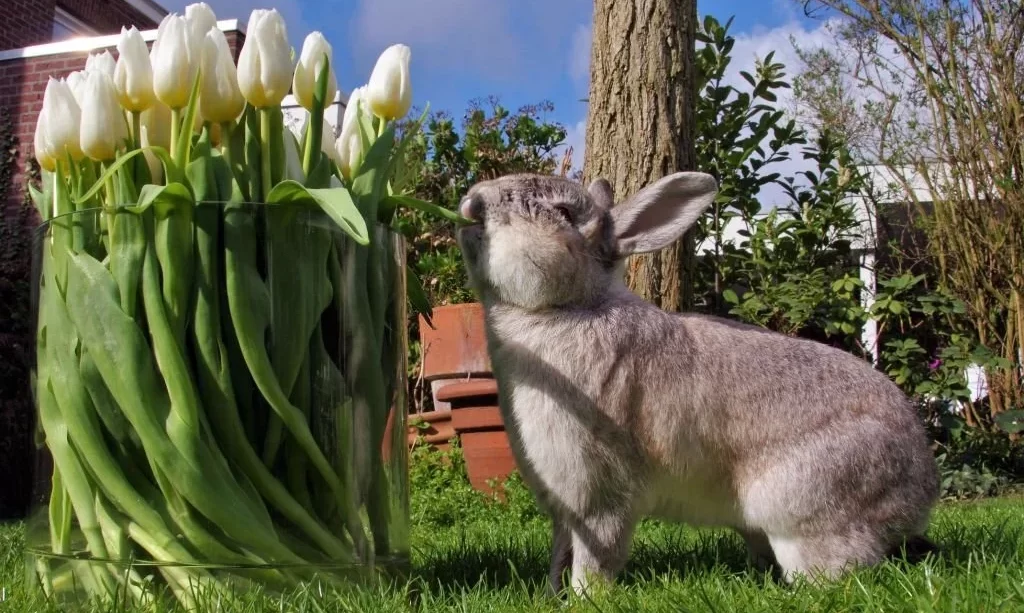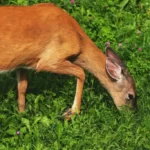Tulips, with their vibrant petals and graceful stature, have long been cherished as the heralds of spring, painting gardens with a burst of color after the winter’s slumber. However, for gardeners, there’s often a nagging concern: do rabbits share our appreciation for tulips? In this article, we embark on a quest to unravel the mystery of whether these adorable yet mischievous creatures find tulips irresistible. Let’s dive into the world of tulips, understand what makes them special, and discover if rabbits indeed have a taste for these springtime beauties.
Tulips
Before we delve into the curious appetite of rabbits, let’s take a moment to appreciate tulips for what they are. Tulips belong to the lily family and are known for their elegant, cup-shaped flowers that come in a breathtaking array of colors. From fiery reds to soft pastels, tulips offer a stunning variety to suit every garden palette. They are heralds of spring, popping up from the ground when the chill of winter starts to fade, symbolizing renewal and the promise of warmer days ahead. Now, with our appreciation for tulips established, let’s turn our attention to the potential culprits behind any tulip troubles.
The Culprit – Rabbits
Ah, rabbits – those endearing, floppy-eared creatures that often frequent our gardens. While they may look adorable, they can also be the source of frustration for gardeners. Rabbits are notorious for nibbling on various plants, and this includes the possibility of munching on your precious tulips. Why do they do it? Rabbits have a keen sense of smell and taste, and they’re often attracted to the tender, succulent shoots of plants. As spring arrives and tulip shoots emerge from the soil, they can become tempting targets for these furry visitors. But do rabbits truly have a taste for tulips, or is it a case of mistaken identity? Let’s find out.
Do Rabbits Eat Tulips?
Now, the pressing question: do rabbits have a culinary appreciation for tulips? The answer is not a simple yes or no. Rabbits are known to nibble on tulips, particularly when they’re in their early growth stages. Young tulip shoots, with their tender leaves and stems, can be quite tempting to these herbivorous creatures. However, it’s essential to note that not all rabbits are equally keen on tulips, and not all tulips are equally attractive to rabbits.
Some gardeners report that certain tulip varieties seem less appealing to rabbits than others. Additionally, the likelihood of rabbits dining on your tulips can vary depending on several factors, including the rabbit population in your area, the availability of alternative food sources, and your garden’s location.
Factors That Influence Rabbit Behavior
Understanding why rabbits might choose to nibble on your tulips can shed light on this behavior. One significant factor is food availability. When rabbits find an abundance of food in their natural environment, they may be less inclined to venture into your garden for a snack. However, in times of scarcity or when their favorite natural foods are limited, your tulips could become more tempting.
Garden location also plays a role. If your garden is adjacent to a rabbit-friendly habitat, such as meadows or wooded areas, you’re more likely to have rabbit visitors. Additionally, the time of year matters. As spring approaches and rabbits become more active, they may seek out the fresh growth in your garden, including your tulips.
In essence, while rabbits may eat tulips under certain conditions, their behavior can be influenced by various factors. To protect your tulips and maintain a harmonious garden, it’s essential to consider these factors and take appropriate measures to deter rabbit foraging, which we’ll explore in the following sections.
Protecting Your Tulips
To shield your beloved tulips from the potential dining preferences of rabbits, there are several practical steps you can take. One effective method is to install a rabbit-proof fence around your garden or tulip beds. This physical barrier can deter rabbits from accessing your tulips. Alternatively, you can use natural repellents like garlic or hot pepper sprays, which can make your tulips less appetizing to these furry visitors. Adding gravel or stones around your tulips can also create an uncomfortable surface for rabbits to navigate.
For tulips in containers, consider elevating the pots out of the reach of rabbits. This not only protects your tulips but also adds an appealing aesthetic to your garden. By implementing these protective measures, you can enjoy your tulips without worrying about them becoming a rabbit’s feast.
- 𝗦𝗜𝗭𝗘: Each decorative garden fence panel is 17 inches high, and 7-inch stake inserts into the soil for added stability, with a width of 13 inches, there are a total of 10 panels that can be connected to form a length of 10.8 feet. The garden fencing can also be expanded into different shapes according to your specific needs.
- 𝗦𝗧𝗨𝗥𝗗𝗬 𝗔𝗡𝗗 𝗥𝗨𝗦𝗧 𝗥𝗘𝗦𝗜𝗦𝗧𝗔𝗡𝗧: Animal barrier fence is made of high-quality thickened metal wire that is welded together and coated with a paint finish to prevent rusting. It is not easily bent and has strong anti-rust and durability properties, making it able to withstand various weather conditions, including sunlight, rain, and snow, without the need for replacement over long-term use.
- 𝗦𝗠𝗔𝗟𝗟𝗘𝗥 𝗜𝗡𝗧𝗘𝗥𝗩𝗔𝗟𝗦: The 1.44-inch spacing of the no-dig fence is smaller than the gaps in ordinary fences, effectively preventing small pets such as kittens, hamsters, moles, hedgehogs, gophers, and groundhogs from passing through.
- 𝗘𝗔𝗦𝗬 𝗧𝗢 𝗨𝗦𝗘: Dog fence requires no assembly, simply insert the stake into the circular hole between two connecting panels and press down firmly, without the need for any tools, to ensure the fence’s stability. This greatly simplifies the installation process and reduces your workload.
- 𝗩𝗘𝗥𝗦𝗔𝗧𝗜𝗟𝗘 𝗨𝗦𝗘: Fence can be used as a decorative garden fence, flower bed fence, animal barrier fence, outdoor dog fence, temporary fence, roadside barrier, pet fence, no-dig fence, and more. It is also suitable for use in patio, porch, corridor, and balcony. (However, please note that this fence may not prevent large dogs).
Encouraging Coexistence
While protecting your tulips is essential, it’s also worth considering ways to peacefully coexist with the local rabbit population. Create a designated rabbit-friendly area in your garden by planting rabbit-preferred vegetation, such as clover or dandelions, away from your prized tulips. This can help divert their attention while preserving your tulip blooms.
Additionally, if you’re a wildlife enthusiast, you might choose to welcome rabbits into your garden with open arms. Observing these creatures in their natural habitat can be a delightful experience. Just be prepared to share some of your garden’s greenery and perhaps consider planting extra tulip bulbs to accommodate both your love for tulips and your fascination with rabbits.
Conclusion
In the end, the question of whether rabbits eat tulips boils down to a nuanced understanding of both the furry culprits and the beautiful blooms. While rabbits may nibble on tulips, particularly when they’re in their tender infancy, gardeners have a range of strategies at their disposal to protect these springtime treasures. From rabbit-proof fencing to natural repellents, there are ways to ensure your tulips remain untouched and vibrant.
However, it’s also worth appreciating the balance of nature and the coexistence of various garden inhabitants. By creating spaces for rabbits to enjoy their preferred vegetation, you can maintain a harmonious garden while safeguarding your tulips. So, as you revel in the splendor of your tulip blooms, consider the gentle dance of nature that unfolds in your garden, with rabbits playing a part in its intricate tapestry.





